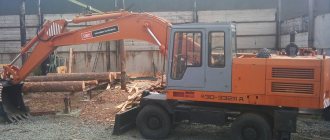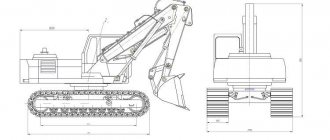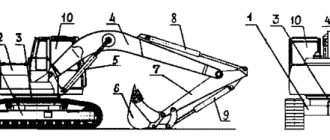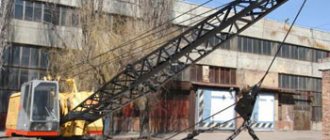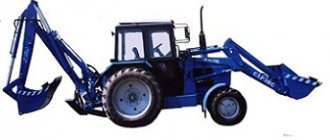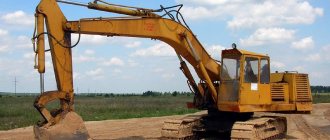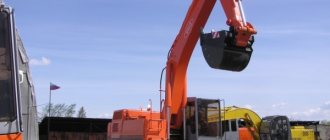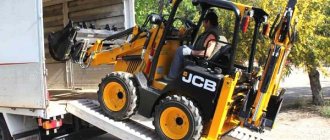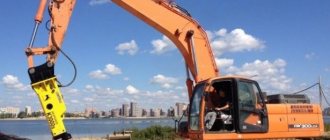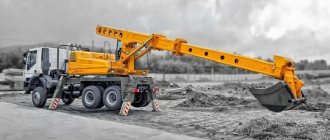The EO-4121 excavator became the very first full-rotary hydraulic crawler excavator in the Soviet Union, which was put into mass production. It belongs to the 4th size group and is designed to perform work with buckets with a capacity of 0.65 - 1.5 cubic meters. "EO-4121" is a typical crawler excavator for most construction sites in the USSR in the second half of the 70s - late 80s of the twentieth century. Serial production of this model and its modernized versions “EO-4121A” and “EO-4121B” was carried out at the Kovrov Excavator Plant from 1974 to 1991.
The purpose of the EO-4121 excavator is the widest range of earthworks: excavation, construction of pits and trenches, construction of new or cleaning of existing reclamation canals, loading of bulk materials and finely crushed rocks with pieces up to forty centimeters in diameter. "EO-4121" can carry out excavation work with soils of categories I-IV - from light loose sand to permafrost and heavy clay soils.
About the history of the model and manufacturer
The debut copy of this earth-moving equipment was assembled in 1970. After passing comprehensive tests, serial production of EO-4121 excavators was launched in 1974 at the Kovrov Excavator Plant, Vladimir Region.
Kovrovsky Excavator is the manufacturer of the first excavator in our country and, in general, one of the oldest enterprises in the entire domestic mechanical engineering industry. It was founded on the production base of railway workshops operating since 1861 at the Kovrov station of the Moscow-Nizhny Novgorod railway.
In 1930, the workshops were transformed into a plant for the repair of foreign-made earth-moving machines. And already on April 21, 1931, the first Soviet excavator in history was built here, which became the ancestor of the extensive family of Kovrovets excavators.
Both in Soviet times and to this day, the Kovrov Excavator Plant is one of the most advanced and leading domestic enterprises in this industry. Over the years of operation, about one hundred thousand units of earth-moving equipment rolled off its assembly line, and the number of different models and modifications reached 64 types. The EO-4121 excavator lasted on the factory assembly line until 1991, and its direct “descendants” were the EO-4124, EO-4125, EO-4224, MTP-71 (“EO-71”) models. 4221"). The modern embodiment of the EO-4121 concept can be called the EO-4225 excavator - a more progressive and advanced version.
Today Excavatorny specializes in the production of full-rotary hydraulic crawler excavators: “KiT-26”, “EO-4225A-071”, “EO-4225A-061” with a full range of attachments. It also produces forestry and loading equipment.
Design features and scope of application of “EO-4121”
The design of the EO-4121 excavator includes a tracked platform with a rotating mechanism. The rotating part houses the working equipment (boom and bucket), control systems, fuel tank, hydraulic system tank, diesel engine, three hydraulic motors, 5 hydraulic cylinders and other hydraulic system components, driver’s cabin and counterweights (at the rear). The turntable rests on the chassis frame through a roller slewing device.
One of the hydraulic motors rotates the excavator platform, while the other two individually drive the tracks. The running gear on this excavator is of a tractor type, and the tension of the caterpillar tracks is carried out using a hydraulic cylinder. The main working equipment of the excavator included: a backhoe with buckets with a capacity of 0.3 to 1.25 m3, a grab, a straight shovel and a straight shovel with a rotary bucket, a loader, and a hydraulic hammer.
The excavator is intended for work in temperature conditions from -40 to +40 degrees (in tropical versions - up to +55 degrees). Thanks to the use of buckets of various volumes and the versatility of the platform, the EO-4121 excavator effectively performs not only excavation work (digging trenches, holes and ditches), but also loading of bulk and finely crushed materials (including using forks or a grab); crushing hard rocks with a hydraulic hammer; loosening the soil with a removable tooth.
Device
Special equipment is available for sale in two assemblies:
- "Standard". Operating temperature range -40°C/+40°C, copes well with cold climates.
- "Tropical". Operating temperature range -20°C - +55°C, suitable for working in tropical climates.
Each assembly consists of 3 main parts:
Rotating platform with hood and mechanisms. It contains:
- engine;
- swing drive;
- hydraulic equipment (pipelines, etc.)
- driver's cabin (it contains the control system for special equipment);
- Crawler trolley;
- Working equipment;
The excavator chassis consists of:
- welded frame;
- caterpillar tracks;
- two track drives;
- wheels with surrender function;
- swivel support (attached to frame):
- skating rinks;
Important Technical characteristics and operating instructions for the KrAZ-260 military truck
The standard equipment of the excavator includes 2 batteries, a generator, a starter, as well as signaling devices common to special equipment:
- temperature;
- fuel level;
- current;
- pressure;
It should be noted that the automatic control system works like a clock and instantly signals any deviations from the norm. Looking at the standard equipment, you can notice many advantages, such as:
- Adaptation to harsh Russian winters.
- Adaptability to work in conditions of high humidity and temperature (“tropical” assembly).
- A comfortable cabin with a wide view, a heater with a front window blower function.
- Components manufactured in Russian factories. This reduces maintenance costs.
- Durability and reliability. The boom, frame and handle of the excavator are made of alloy steel with a strength class of 390.
The EO-5126 excavator was developed on the basis of the design bureaus of the Ministry of Defense, therefore it is balanced in characteristics, reliable and can withstand extreme use.
dimensions
| Characteristics (in transport position) | Meaning |
| Weight | 32 t. |
| Length | 10.4 m |
| Width (600 mm tracks) | 3.17 m |
| Width (900 mm tracks) | 3.47 m |
| Height | 3.1 m |
| Turning width platforms | 3.04 m |
Bucket characteristics:
Type – basic, earth-moving bucket. The volume of the installed bucket is 1.45 cubic meters. The largest volume of the installed bucket is 1.8 cubic meters.
Type – trench bucket. The volume of the installed bucket is 0.8 cubic meters.
Type – reinforced earth-moving bucket. The volume of the installed bucket is 1.25 cubic meters.
Excavator engine "EO-4121"
The EO-4121 excavators were equipped with diesel engines of the A-01 and A-01M brands from the Altai Motor Plant, Barnaul. It is simple in design and maintenance, unpretentious, high-quality motor, which is still produced and installed on a number of agricultural, industrial and forestry tractors, and on road construction equipment.
A six-cylinder four-stroke naturally aspirated diesel engine of type “A-01” is equipped with a two-valve gas distribution mechanism on each cylinder. The arrangement of the cylinders is in-line, vertical. The mixture formation method is direct fuel injection. Cooling method – liquid.
Engine "A-01M". It is still produced for a wide range of special equipment.
In the design of the motor, special cast iron liners were used, with the working surface treated by flat-top honing; pistons with a three-ring set of piston rings, optimized side surface profile and graphitized skirt; crankcase with increased strength and improved cooling of cylinder liners. The engine has a solid service life (up to 12,000 operating hours).
- Cylinder displacement: 11.15 l;
- Rated power: 99 kW, or 135 hp;
- Cylinder operating order: 1-5-3-6-2-4;
- Cylinder diameter: 130 mm;
- Piston stroke: 140 mm;
- Compression ratio: 16.5 (+/- 0.5);
- Rated crankshaft rotation speed – 1700 rpm;
- Nominal torque reserve factor – 25%;
- Specific effective fuel consumption at rated power – 221 g/kWh (163 g/hp-h);
- The relative oil consumption for waste is 0.3% of fuel consumption.
The high-pressure fuel pump of the A-01 engine is of the spool type, not the plunger type. The injectors are installed with a multi-hole nozzle. The air filter is a centrifugal cyclone type. The launch is carried out using a single-cylinder starting engine “PD-10U” with a power of 10 hp. It is filled with gasoline with 1/15th of motor oil.
The A-01 engine drives two hydraulic pumps with adjustable output. Both pumps are installed in the same housing and driven through a gearbox. Additionally, a pre-start heater “PZHB-300V” is installed, which makes it easier to start the engine in conditions of especially low temperatures.
Dimensional parameters of excavators with rigid equipment suspension
When working with a straight shovel
Table 21
| Index | EO-4121A | EO-4123 | EO-4321 | EO-5122 | EO-6121 |
| Digging depth below parking level, m | 3,6 | 3,34 | 3,04 | 4,13 | 4,85 |
| Minimum digging radius, m | 4,12 | 4 | 4 | 4,7 | 5,3 |
| Maximum digging radius, m | 7,25 | 7,45 | 7,45 | 8,93 | 10,15 |
| Maximum lifting height of the bucket, m | 7,5 | 7,4 | 7,7 | 9,65 | 10,3 |
| Maximum unloading height, m | 5,03 | 6,1 | 6,4 | 5,1 | 4,95 |
| Unloading radius at the highest unloading height, m | 5 | 6 | 6 | 4,62 | 6,7 |
When working with a backhoe
Table 22
| Index | EO-3121B | EO-3322A | EO-4121A | EO-4123 | EO-4121 | EO-5122 |
| Handle length, m | 2,8 | 2,58 | 2,99 | 2,93 | 2,93 | 2,97 |
| Maximum digging depth, m: | 4,5 | 4,2 | 5,8 | 5,6 | 5,5 | 6 |
| Maximum digging radius, m | 7 | 7,6 | 9,2 | 8,95 | 10,16 | 9,6 |
| Maximum unloading height, m | 5,5 | 4,7 | 6 | 5,88 | 6,18 | 5 |
Machines and devices for auxiliary work
Table 23
| Index | DP-8A | DP-3 | DP-2 | D-695A | DP-25 |
| Basic tractor | Crawler DT-75B-S2 | Crawler T-100MZGP | Crawler T-100MZ | Tracked T-100MZGBP | Tracked T-130.1G-1 |
| Engine power, kW | 55,1 | 79,4 | 79,4 | 79,4 | 117,6 |
| Blade width, m | 2,13 | 1,5 | 1,54 | 3,53 | 1,38 |
| Overall dimensions, m: | |||||
| length | 5,05 | 5,61 | 5,55 | 6,36 | 5,83 |
| width | 2,68 | 3,3 | 3 | 3,87 | 3,25 |
| height | 2,3 | 3,05 | 3,05 | 2,75 | 3,05 |
| Working width, m: | |||||
| uprooter | 0,72 | 1,38 | 1,38 | 2,09 | 1,38 |
| uprooter-gatherer | 2,18 | 1,38 | 1,38 | 3,53 | 1,38 |
| Largest diameter of uprooted stumps, m | 0,5 | 0,45 | 0,45 | 0,5 | 0,45 |
| Produce activity: | |||||
| When uprooting stumps, pcs/h | 45 | 40 | 40 | 59 | 40 |
| When uprooting bushes and collecting stumps, ha/shift | 1,6 | 3,5 | 3-5 | 2,4 | 3 |
Drilling machines
Table 24
| Index | BM-204 | BM-205 | BM-202 | BM-302 | BM-802S | BM-303 | BM-251 |
| Basic car | Wheel tractor | Automobile GAZ-66-02 | Automo bill | Crawler | |||
| MTZ-52L | MTZ-82L | KrAZ-257 | T-74-S2 | DT-75-S2 | |||
| Drilling depth, m | 2,1 | 2 | 2 | 3 | 8 | 3 | 2,5 |
| Well diameter, m | 0,35; 0,5; 0,8 | 0,35; 0,5; 0,8 | 0,35; 0,5; | 0,8 | 0,3; 0,4; 0,65 | 0,35; 0,5; 0,8 | 0,6; 0,8; 1 |
| Bulldozer blade: | |||||||
| length, m | 2 | 2,1 | — | — | — | — | — |
| height, m | 0,65 | 0,64 | — | — | — | — | — |
| Overall dimensions in transport position: | |||||||
| length | 6,3 | 6,1 | 6,55 | 6,55 | 12,41 | 5,67 | 4,88 |
| width | 2 | 2,25 | 2,34 | 2,34 | 2,78 | 2,15 | 1,75 |
| height | 3,96 | 3,72 | 3,05 | 3,37 | 3,93 | 3,74 | 3,16 |
| Overall dimensions in working condition position: | |||||||
| length | 6,2 | 6,1 | 6,55 | 6,55 | 12,41 | 4,8 | 4,7 |
| width | 2 | 2,25 | 2,34 | 2,34 | 2,78 | 2,15 | 1,75- 2,27 |
| height | 5,16 | 4,8 | 3,65 | 4,2 | 3,93 | 8,85 | 3,96 |
studfiles.net
Chassis
The chassis is a tracked mechanism in which each track receives force from an individual hydraulic motor through a gearbox. The hydraulic cylinder is responsible for tensioning the track. The design of the chassis is equipped with widened links, which can significantly reduce the pressure on the ground. This option is intended for use on waterlogged and weak soils.
The turning mechanism includes a three-stage gearbox, a rotary gear and a hydraulic motor, consisting of safety and distribution equipment, a double pump and executive working elements. The performance of pumps mounted in a single housing can be adjusted. They themselves are started by diesel engines through a transfer gearbox. On the turntable behind the cab there are spool distribution blocks.
The crawler trolley of the EO-4124 excavator is equipped with tracks made of cast tracks with lantern gears. Nowadays, such a solution is no longer used, or is used quite rarely. However, it provides excellent reliability and wear resistance of excavator tracks. As a rule, the service life of tracks of this design is two to three times longer compared to conventional tracks.
Advantages and disadvantages
Most models have:
- Low cost. They are productive and do not require large operating costs.
- High maintainability.
- Mobility, high cross-country ability.
- They work in winter and hot weather without interruption.
- Not afraid of dust.
- They have or can be equipped with interchangeable attachments, which expands their versatility.
Disadvantages include:
- weak hydraulic hoses;
- Difficulty starting engines in cold weather;
- difficulty in mastering management.
Hydraulic system of the excavator "EO-4121"
The hydraulic drive of the excavator includes: a double pump, distribution and safety equipment, executive working elements. Hydraulic pumps of adjustable capacity, mounted in a single housing, are driven by a diesel engine through a transfer gearbox. The spool distribution blocks are mounted on a turntable behind the cab. The pressure of the working fluid in the hydraulic circuit of the drive of the working parts of the excavator was ensured at the level of 250 kg/cm, which for those times was a record figure for both the Soviet Union and Europe.
Shovel (piping not shown)
- tracked undercarriage; 2- support-swivel device;
3-turn platform; 4- engine; 5- driver's cabin; 6-hinge
connecting the boom to the turntable; 7- lower part of the boom;
8- upper part of the boom; 9- traction; 10,11,12 - hydraulic cylinders; 13- handle;
14- bucket lever; 15-bucket
A backhoe excavator excavates the soil below the standing level. When operating a backhoe, great forces are realized, since the resistance of the soil during digging is overcome not only by the force developed by the working equipment, but also by the weight of the entire machine. In addition to the one shown in Fig. 2, one-piece (monoblock) booms and extended handles, profile buckets are used for digging and cleaning channels and ditches.
The movement of the boom, arm and bucket when digging and unloading the bucket is carried out by the coordinated operation of the corresponding hydraulic cylinders.
To reduce cycle time and increase productivity, the operator combines raising the working equipment with rotating the platform to the unloading site, lowering the boom with a reverse rotation to the face.
-5-
Rice. 3. Working equipment of a straight shovel
Excavator EO – 4121a
a- with a fixed bucket; b- with a rotating bucket.
- arrow; 2- handle; 3- traction; 4- bucket tooth; 5- ladle; 6- bottom loop
ladle; 7,8,9,10 - hydraulic cylinders; I and II – bucket positions when digging.
A straight shovel excavator excavates the soil above the standing level. The bucket can be attached rigidly to the handle using rod 3, and then a special hydraulic cylinder 7 is installed to open the bottom. If the bucket is attached to the handle pivotally (position “b”), then its rotation relative to the horizontal axis is carried out using hydraulic cylinder 10; the hydraulic cylinder body is pivotally attached to the handle lugs, and the rod is also pivotally attached to the bucket.
On most hydraulic excavators (including EO-4121A), when installing front shovel equipment, they use (in whole or in part) a backhoe boom.
A straight shovel with a rotating bucket can be used not only to excavate and load soil, but also to level the face; the shortage of soil when operating a hydraulic straight shovel is less than for a mechanical excavator.
A dragline excavator (Fig. 4) always has a flexible suspension of working equipment and a mechanical (single-engine) or diesel-electric (multi-engine) drive (see Fig. 5).
A dragline develops the soil below the standing level. The dragline operating cycle consists of casting the bucket, pulling the bucket while simultaneously filling it with cut soil, lifting the bucket, turning the boom to unload and turning back into the face.
-6-
Rice. 4. Dragline excavator
- winch boom lifting drum; 2- winch traction drum;
3-fixed blocks; 4- lifting rope; 5- traction rope; 6- ladle;
7- movable blocks; 8- arrow; 9- boom head block; 10- lifting chains; 11- traction chains; 12- unloading rope; 13- tip; 14- rope;
15-rope traction.
When throwing the bucket 6, the lifting rope 4 is released from the winch drum 2, passing through the head block 9 of the boom 8, and from the other drum of the double-drum winch 2 (see Fig. 4 and Fig. 6), the traction rope 5, passing through the tip 13 and attached to the bucket by means of traction chains 11. The boom is held at a given angle using a pulley, consisting of a suspended crossbeam with movable blocks 7, fixed blocks 3 and a rope 14, going to the boom-lifting drum of the winch 1. The crossbeam and the head of the boom are connected by rope rods 15.
The bucket is moved along the face slope and filled with soil using a traction rope while simultaneously releasing the lifting rope. After filling, the bucket is raised and held by chains 10 while simultaneously tensioning the traction rope. When turning to the unloading site, the traction rope is released, the unloading rope 12 is weakened; since the axis of the bucket suspension on the lifting chains does not pass through the center of gravity (it is located closer to the cutting part), the bucket tips over and is freed from the ground. At a larger rotation angle, the bucket is unloaded into the dump using a circular motion of the turning part.
-7-
Rice. 5. Schematic diagram of a multi-engine diesel-electric drive of a dragline excavator.
(only one “branch” of the drive is shown)
- diesel; 2- friction clutch; 3- electric generator;
4-distribution device; 5-starting and control device;
6- electric motor; 7- coupling and shoe brake;
8- gearbox; 9- actuator.
The diesel engine and generator essentially form a mobile power station that powers the electric motors. The multi-motor drive is compact; the electric motor, coupling and gearbox are structurally a single unit and are located directly next to the actuator. The autonomy of each branch allows control functions to be performed independently and makes it possible to combine work operations.
In Fig. 6. shows the kinematic diagram of the drive of a double-drum dragline winch (traction and lifting ropes in Fig. 4)
Rice. 6. Kinematic diagram of the double-drum winch drive
- electric motor; 2- coupling; 3- gearbox;
4- friction pneumatic chamber clutch; 5- band brake; 6- traction winch drum; 7- drum of the bucket lifting winch.
The electric motor is connected by means of a coupling to a two-stage gearbox, on the shaft of which the driving halves of the pneumatic chamber couplings are rigidly fixed. The drums of winches 6 and 7 rotate freely, they are turned on when air is supplied to the pneumatic chambers. When the drive is turned off, the drum slows down.
-8-
studfiles.net
Cabin of the excavator "EO-4121"
Since the EO-4124 was the very first model of a full-rotary excavator in the USSR, its designers were faced with the task of balancing it on a turntable. At the same time, it was necessary to create a significant advantage in the rear part - this would make it possible to significantly increase the force developed on the bucket. For these reasons, the cabin and engine of the EO-4121 excavator are separated by two meters, which in our opinion looks quite exotic. It can also be noted that the 2 hood doors are also located in the rear of the excavator, and not in the side. An additional counterweight is installed in the same place.
The cabin, from a modern point of view, is an ordinary “tin box”, reminiscent of a “birdhouse”, with the most minimal set of amenities for the driver. However, it is equipped with ventilation and heating, heat and noise insulation, a seat with a soft cushion, as well as a number of instrumentation and control levers. Light bulbs are provided for lighting and signaling.
In most cases, the EO-4124 excavator is operated with a backhoe bucket with a capacity of 0.6 m. This allows the development of soils that have not previously been loosened. About 50 types of various attachments can be installed on the hydraulic boom: hydraulic hammers of various capacities, a loading bucket, a bucket for loose soil with a volume of 1.3 m and more.
Definition and purpose
An excavator is a machine for digging soil. The working body is a bucket. It can be of different designs. To expand functionality, replaceable equipment is used: crane (hook), hydraulic hammer, pile driver, etc. In addition to the “classic” equipment, there are backhoe loaders and mini-excavators. According to the principle of operation, excavators are divided into the following types:
- Cyclic (cyclic action). This includes single-bucket machines.
- Continuous action. This group includes: multi-bucket rotary, with a front cutter, trench with a toothed chain.
- Vacuum.
Below we consider only the first category - an excavator with a bucket. By purpose, the following classification is adopted:
- Construction. Bucket volume up to 3 m3. They are mainly used for excavation or loading and unloading work. Most models are universal (that is, they have 4 or more types of interchangeable equipment).
- Career. They are equipped with working equipment from 2 m3 to 8 m3. They are used in quarries for the development of rock, coal or ore deposits.
- Overburden. Bucket capacity from 6 m3. They are used when it is necessary to remove (open) the top layer of rock, under which useful minerals lie. A distinctive feature is an elongated boom and greater power.
Special equipment is included in a separate group. This includes peat, destructive, tunnel, rescue, underground, railway, underwater, swamp and other models. They require special equipment and attachments.
Replaceable work equipment
On EO-4121 excavators you can install rotary or fixed buckets. The rotary one significantly expands the scope of application of the excavator, since it can not only develop and load soil, but also plan the face. A feature of the working equipment of the grab for the EO-4121 excavator is the use of the base and head parts of the boom, the handle and the hydraulic cylinder of the reverse handle shovels. The grab bucket consists of two jaws and two rods.
Front and back shovel buckets with a capacity of 1 cubic meter are designed for developing soils up to the fourth category, and a bucket with a capacity of 0.65 cubic meters is designed for working with crushed rocks and loosened frozen soils. A loader bucket with a capacity of 1 cubic meter loads soils and materials with a volumetric mass of up to 2.2 tons per cubic meter, and a bucket with a capacity of one and a half cubic meters loads soils and other materials with a volumetric mass of up to 1.6 t/m3.
The permanent equipment of the EO-4121 excavator includes a handle and one type of shovel. Replaceable equipment includes equipment that is installed specifically, depending on the type and nature of the work being performed at a given time. The list of replaceable equipment "EO-4121" is as follows: a backhoe with a handle of different lengths; profile bucket; straight shovel with bucket; gripping and pincer mechanism; loading forks; hydraulic hammer; ripper; hydraulic shears; magnetic plate; grab equipment.
Device
The single-bucket excavator "EO-3322" consists of the following main components and systems: pneumatic wheel running device, turntable, working equipment, hydraulic system, pneumatic control system, electrical equipment.
The pneumatic wheel running device of the excavator, made on two drive axles, provides a travel speed of up to 20 km/h on work sites and on roads, as well as the ability to tow the excavator with a tractor. The front axle is steered, on single tires, and is balancedly attached to the running frame.
The rear axle is unsteered, has double tires, and is rigidly connected to the running frame.
The axles are driven by a low-torque hydraulic motor through a gearbox and cardan shafts. During excavation work, to increase stability, the excavator rests on folding supports and a blade support.
The turntable is attached to a turntable mounted on the running frame. The following are installed on the turntable: diesel engine, fuel tank, turning mechanism, cabin, heating and ventilation unit, hydraulic equipment (hydraulic tank, hydraulic valves, oil cooling unit), elements of electrical and pneumatic equipment, counter-weight. The excavator's working equipment is installed in the eyes of the turntable and secured with pins.
Working equipment
The EO-3322 excavator is equipped with a standard 0.5 cubic meter bucket fixed on a backhoe. In addition to this “standard” size bucket, this excavator uses buckets with a volume of 0.2; 0.4, 0.65 and 0.8 cubic meters, which facilitates the work of loading bulk materials or loosened soil. The dump support significantly expands the technological capabilities of the EO-3322 excavator, providing it with the ability to backfill trenches, holes and level small surface areas.
The excavator is also compatible with other types of attachments, namely:
- with various models of rippers belonging to the static type - for the preliminary development of particularly hard soils (rocky, frozen, rocky);
- with a hydraulic hammer “SP-71” and similar;
- with a 5-jaw bucket of 0.5 or 0.35 cubic meters;
- with an extended handle;
- with a 2-jaw grab bucket with a volume of 0.5 or 0.32 cubic meters.
The “EO-3322” excavators that are currently available on the secondary market for special equipment can often be equipped with “non-original” elements and structural units of much newer releases; as well as more powerful hydraulic equipment, etc. These home-made innovations, combined with the original strength, reliability and functionality of the excavator, give it the opportunity to be on par with, and sometimes even surpass in performance new models of construction and municipal excavator special equipment.
Important What are the good technical characteristics of the Kirovets K-424 tractor
Cabin
The excavator has an all-metal cabin with a large glass area, which is also located below the operator’s seat. The cabin of the EO-3322 excavators of later years of production is equipped with a sprung seat with a variable backrest angle. The seat position can be adjusted in depth and height.
The front window of the cab can be folded back and locked in this position.
The door is equipped with a lock. There is a lock on the left outer wall of the cab to hold the door in a permanently open position. The cabin floor is covered with a vibration-isolating mat made of durable rubber.
To ensure normal working conditions for the operator, a heating and ventilation unit is installed in the cab. The air in the cabin is heated by circulating hot water from the engine cooling system to the heat exchanger of the heater and back through the hoses. When the fan is turned on, the air in the cabin is blown through the heat exchanger. During the warm season, the flow of hot water into the heat exchanger is stopped using a shut-off valve.
To provide access to outside air into the cabin, it is necessary to open the heater damper using the handle. If the coolant supply is turned off, the EO-3322 cabin heater can be used as a regular fan.
What can be included with
All modifications of EO-3322 are equipped with buckets, your choice: 0.2; 0.32; 0.4; 0.5; 0.63; 0.8 m³ – for front and backhoes. Models B, D are equipped with:
1. grab equipment:
- 2-jaw buckets 0.32; 0.5 m³;
- 5-jaw 0.35; 0.5 m³.
2. Hydraulic mounted:
- hammer;
- ripper;
- loader
Depending on the size and type of equipment, productivity may decrease or increase.
Technical specifications in numbers
General parameters of the EO-4121 excavator:
- Wheel formula – 4 by 4;
- Length without bucket – 4.9 m, width – 2.9 m, height – 3.060 m;
- Track base – 2,750 m;
- The size of the caterpillar track is length 2.93 m, belt width 0.58 m;
- Platform revolutions per minute – 6;
- Platform width – 3 m;
- Ground clearance under the turntable – 942 mm;
- The height of the arrow heel axis is 2.02 m;
- The distance from the heel axis to the axis of rotation is 520 mm;
- Weight with a front shovel - 19.87 tons, with a backhoe - 20.9 tons, with a grab - 20.9 tons, with a loader - 19.87 tons;
- Travel speed – 2.8 km/hour.
- The surmountable slope of the path is 22 degrees;
- Productivity – up to 150 cubic meters per hour.
Characteristics of the working bucket model:
- Capacity – from 0.65 to 1.5 cubic meters;
- Digging radius – 9.2 m (backhoe); 7.25 m (straight shovel); 8.9 (grab); 3.75 m (by loader);
- The radius described by the tail part of the platform is 3.13 m;
- Digging depth – 5.8 m (backhoe); 3.6 m (straight shovel); 3.2 m (grab);
- Loading height – 5 meters;
- The force on the bucket teeth is 14,200 kgf;
- Cycle time – with straight shovel and loader: 16 seconds; with backhoe: 20 seconds.
Depending on the type of bucket used, these data may vary slightly. The specific ground pressure indicator for EO-4121 brand excavators is 63.6 kPa, the minimum cycle duration at a 90-degree rotation angle is 18 seconds.
Video
The excavator is a classic representative of the construction equipment segment of the 70-80s. The model can safely be attributed to the ancestors of full-rotary earth-moving machines, since it was on it that the principle of hydraulic rotation of equipment was first applied. The key point was to increase the pressure in the hydraulic system to 250 kgf/sq.cm, which made it possible to maximize the power and productivity of the equipment.
Another advantage of the excavator was ease of maintenance, due to ease of access to any components and mechanisms of the excavator. This quality made the equipment cheaper to operate and speeded up the repair process.
Parts of the power plant, body and equipment of the EO-4121 were made of high-strength metal, which protected against corrosion and prevented rapid destruction. A clear indication of the incredible durability of the model is that some pieces of equipment are still in operation today.
The optimal location of the center of gravity and the presence of counterweights made it possible to achieve increased stability during operation.
EO-4121 was produced with replaceable working equipment (backhoe or front shovel, loader, grab) and buckets with a capacity of 0.65 to 1.5 cubic meters. The excavator was intended to work in areas with a temperate climate and temperature conditions from -40 to +40 degrees (in the tropical version - up to +55 degrees).
The release of this model was due to significant economic efficiency in comparison with equipment of the E-625B category with a mechanical drive.
Reviews about excavators "EO-4121"
There are few reviews on the Internet from people who actually had experience working with EO-4121 excavators. Most of them boil down to one thing: it was a good excavator, simple, reliable and unpretentious.
In any case, hydraulic excavators are more productive and convenient to use than excavators with a cable-pulley control system. Therefore, the creation and implementation of the EO-4121 excavator significantly improved the performance of earthmoving work on Soviet construction sites.
It is also noted in the reviews that crawler-mounted excavators are much more stable and safer to operate than pneumatic-wheeled excavators. True, the speed of crawler excavators is extremely low, and they need to be transported from one site to another only on trailers.
Former operators of the EO-4121 excavators note that its design has a minimum number of parts (without compromising functionality), and it is very repairable. It has a fairly high degree of unification with many models of domestic and imported excavators (in particular, hydraulics). This makes it relatively easy to select the necessary spare parts for it.
The excavator cabin, of course, lacks convenience and ergonomics. When using foot pedals, it is not always possible to reach the levers, and when operating the levers in the most appropriate way, your feet begin to rest against the glass. Such shortcomings, coupled with the general inconvenience of the “birdhouse,” force the excavator operator to work in an awkward position and strain his back. Which ultimately leads to a decrease in its efficiency and productivity.
Modifications
A total of two modified versions of this crawler excavator were produced, namely EO-4121A and EO-4121B. The most popular version of them was the second modification.
The EO-4121B differs from the basic excavator in having a reinforced boom, due to which the scope of application of the equipment has been expanded. The machine began to be used for quarrying and loosening rocks. In addition, this change allowed the excavator to work with very heavy weights, which is also a big plus.
EO-4121B
The machine can use a hydraulic breaker, pincer-type gripper, as well as loosening equipment in the working process. All this allows the equipment to carry out stripping work in frozen and rocky soils.
The operator's cabin is located on rubber shock absorbers, which absorb strong vibrations and shocks that occur during operation. The cabin also has an adjustable seat and transport air conditioning (installed optionally).
Price of a used excavator "EO-4121"
New excavators of the EO-4121 brand no longer exist in our time, since the production of this model ended almost three decades ago. There are very, very few used excavators on the secondary market, for the same reason - their purely physical obsolescence is too great. "EO-4121" from the 80s are offered for use for spare parts for 80-100 thousand rubles. For copies on the move they ask for more - up to 300-350 thousand rubles. The cost of a machine-hour of work on the “EO-4121” will be within 1000 rubles (+/- a couple of hundred).
Analogs of the EO-4121 model include the MPT-71, EO-4225 and EO-4125 excavators, newer and more advanced earth-moving machines that replaced it.
Options for purchasing the EO-4112 model
The price for the EO-4112 excavator can be completely different. For used models of earlier years of production, the cost will be within 800,000 rubles. As for models that were produced in a later period and are characterized by minimal mileage and excellent technical condition, the cost can increase up to 3 million rubles. The purchase of this equipment is justified by its technical indicators and high performance in different conditions. If you need to perform one-time work, then it is more advisable to rent equipment for a certain period of time. The cost of renting the EO-4112 model today will vary within 12,000 rubles for an 8-hour working day. Costs may increase when transporting equipment to the job site. Knowing all the prices, you can determine which option is best suited in a particular case.
